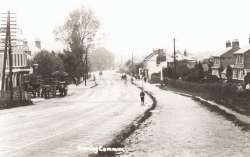History of Bromley Common
Bromley is a large parish. Historically the main settlement was towards the northern end but by the sixteenth century a subsidiary settlement had developed at the southern end, the two being separated by Bromley Common, which straddled the Hastings Road.
Enclosure of the common began in 1764 with the rest following in 1821. Shortly after, villas began to appear along the Hastings Road as Bromley developed as a fashionable spa. The Hamlet at the southern end grew too, sufficiently for Holy Trinity Church to be built in 1839. The area continued to grow into the twentieth century, with a bus garage opening in 1924.
The northern part of the common, known historically as Shooting Common began to develop after 1870 under the influence of the railway, which arrived at Bromley in 1858. Dense development of small cottage style accommodation grew quickly complete with a local shopping centre around Chatterton Road and schools in Raglan Road. St. Luke’s Church opened to serve this area in 1887.
The southern part of the common remains fairly undeveloped, providing a green lung between the Victorian developments to the north and the twentieth century building to the east and south. This is due in part to the influence of the Norman family who remained in residence at the Rookery, now the site of Bromley College of Education, until the Second World War. Less interested in development than their neighbours, by the time their lands became available, changes in planning legislation had prevented the large-scale building that had taken place to the north. Norman Park and Rookery Lane remain as reminders of their influence.








